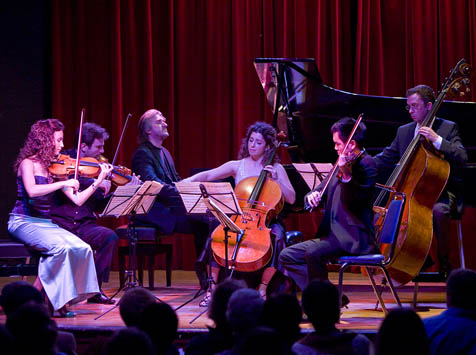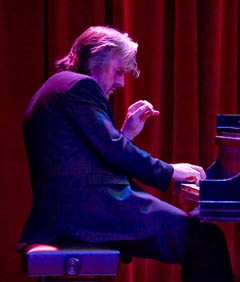Camerata Pacifica
At the Santa Barbara Museum of Natural History

Among the dinosaurs and butterflies at the Santa Barbara Museum of Natural History, the crowd sensed something powerful would arrive soon, and it did. Barry Douglas and a string quintet of Camerata Pacifica veterans-Catherine Leonard and Stefan Milenkovich, violins; Richard O’Neill, viola; Ani Aznavoorian, cello; and Timothy Eckert, double bass-began delicately with Mozart’s Piano Concerto No. 12 in A Major, but soon rose up in full strength and brilliance. The reduction of the orchestra to a quintet (an ordinary practice in Mozart’s time) did nothing to reduce the power of this extremely capable group. Their phrasing was exceptionally subtle, balancing Mozart’s classical symmetries while revealing each theme’s individual character. Douglas knows where all the jokes are in this work, and he tells them well, dazzling us with the cleverness of a high motif in the right hand, and then bringing us back to earth with rich, thick chords in the left.

From there, Douglas gave us a lesson in the development of the piano repertoire we won’t forget. He played Beethoven’s Sonata No. 21 in C Major (known as “Waldstein” for the kind and encouraging Count to whom it is dedicated) as if to illustrate exactly what Beethoven added to the tradition: a sense of self-determination. Douglas showed us the opening motif boldly and simply, and then explored the allegro’s complex development with clarity and wit. The rest of the sonata, a brief andante that goes straight into the finale without pause, hinted at what would come after the intermission: more than a half hour of continuous virtuosity.
Lizst’s B Minor Sonata overwhelmed the audience, but Douglas was in full control. The work begins with a few disconnected notes and rests, and then gathers speed and density as it hurtles along. Douglas’s performance demonstrated remarkable depth; he brought its four extraordinarily difficult movements into a single meditation on the power of sound. Despite all of Liszt’s-and Douglas’s-sophistication, something almost primitive emerges at the end: a single note, then silence, then another note, as if a child were touching the instrument for the first time. We are fortunate to have Douglas and Camerata Pacifica here to bring us back to that moment, when we were wondering what an instrument could do, and to show us its unlimited potential.



